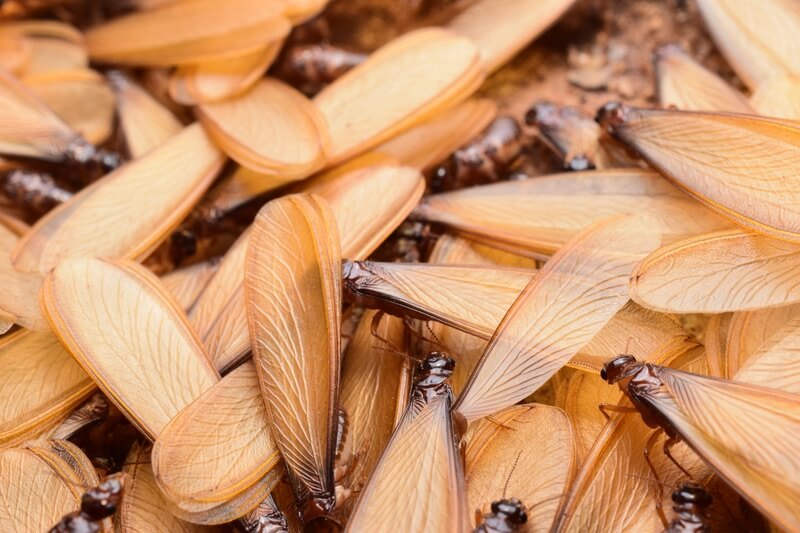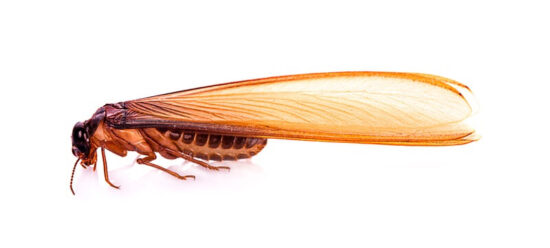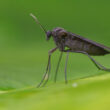Learning how to get rid of flying termites is essential if you live in an area where these insects are a problem. But unfortunately, there’s a lot of misinformation out there on the right way to deal with them.
This guide will teach you how to get rid of flying termites in your house, as well as outside.
Table of Contents
What Are Flying Termites?
When the rest of the country is celebrating the arrival of spring and the warmer weather that spring seems to promise, homeowners in the southern part of the United States are crossing their fingers, getting their spray cans ready and are putting their exterminator’s phone number on speed dial. There, spring is the season for flying termites.
If you’re not from that part of the country, then you can have no idea of the terror that flying termites can bring. These flying termites are sometimes known as “swarmers” because they fly in large swarms as they search for mates and new places to set up their colonies. At any one time, hundreds of flying termites can be seen swarming around street lamps or porch lights.

Not all termites in a colony can fly, so the ones that do fly are reproductive males and females looking to hook up, find a nice place to set up a new colony and begin to reproduce at exponential rates. Once a queen is established and starts doing her thing, she can lay up to 30,000 eggs a day. This means that a colony of 100 termites can turn into literally tens of thousands in a few years. Left long enough, that number can spike into the millions.
These flying termites are going to try to get into any crack, crevice or hole in a home they can possibly get into to set up their newest colony. After that, once the colony is established, the colony can eat up to 25 pounds of wood per year. Grossed out yet? It gets worse because you may not even realize that your home is infested until the colony has been there for years. So if you see flying termites swarming around your bedroom lamp or in your bathroom, it’s important to know how to get rid of them.
What Do Flying Termites Look Like?
Flying termites have a pretty distinctive body structure. These insects are around an inch long and usually have dark brown bodies. While they’re often confused with other insects, it’s actually not that hard to identify them once you know what to look for (more on that later).
Signs They’re In Your House
It’s very important to be aware of any indication that you have flying termites in your home. If you notice any one of the signs we will be discussing, you’ll need to take action to get rid of them right away. Evidence of flying termites in your home is a good indication that there is a colony already established in or near your home.
If you live in a part of the country where there is springtime termite activity, then giving your house a good, all-over inspection a couple times a year is an excellent idea. Let’s check out some of the things to look out for that indicate you have a flying termite problem.
Hollowed Wood
One thing to keep an eye out for when getting rid of flying termites is hollowed wood. Hollowed wood can be found outside or inside the house, and many times it’s not found until lots of damage has been done.
Termites, especially drywood termites, eat wood from the inside of the wood to the outside. You may not even notice that the wood has been eaten until you touch it, and the wood just crumbles. This is wood that has been hollowed out by the termites, and it’s a pretty sure sign that there is a termite colony somewhere nearby.
Expert Tip: If you suspect that flying termites are present, then you can randomly tap on indoor walls and on wooden structures outside the home. A hollow sounding piece of wood may be an indication of a termite infestation.
Blistered Wood
Another good sign that you might have flying termites you need to get rid of is the presence of blistered wood or blistered walls. At first glance, this blistering may look like water damage, but if you are in a termite-prone area, there’s a good chance that it’s from termites.
How can you tell the difference between water damage and an invasion of these insects? One way is to decide whether water damage is even a possibility. If you find the blistering in a spot that isn’t even near a water source, then chances are that you are dealing with termites.
Lightly tap the area around the blistered-looking spot. Does it sound hollow? If it does, you probably have flying termites close to the surface. That means you’ll need to take action to get rid of the swarming termites you have in your house.
Droppings
Droppings (also called frass) are a sure sign that these insects are present. Droppings come in colors from beige to dark brown, and many people describe them as looking like coffee grounds or sawdust. Droppings are often a homeowner’s first clue that there is a termite problem, and piles of frass can be found near baseboards, under or around furniture or on wood floors.
When the galleries become too full of waste material, the winged termites will make a small hole in your wall, floor or furniture, and they push all of the waste out, creating an obvious pile of droppings.
Mud Tubes
Subterranean termites (termites that create elaborate underground colonies) are extremely destructive. One way to tell if your home is being attacked by subterranean termites is the presence of mud tubes. In order to protect themselves from predators, cold or dry air or from other dangers, these insects create tunnels that allow them to travel between the nest and their food source in safety.
The mud tubes kind of look like curvy pencils made out of mud, and you will often find them along the foundation of your home.
Expert Tip: To see if it’s an old tube, break off a piece of it. If it’s repaired in a few days, then the area is still active and you likely have flying termites you need to get rid of.
Visible Flying Termites
Two obvious signals that you have a problem are visibly flying termites and the presence of termite wings on windowsills and other areas. After termites mate, they shed their wings and search for a place to start a new colony.
Seeing wings around means that you have mature termites in or around your home. It goes without saying that seeing flying termites is proof positive that they are around and in search of a new home.
How To Get Rid Of Flying Termites
We can’t stress enough the importance of getting rid of swarming termites as soon as possible. If you see any of the signs mentioned above, you absolutely need to take action or get in touch with a pest control specialist as soon as possible. Termites are such a complex issue, that most pest control companies have a separate approach just for dealing with termites.
Don’t procrastinate because you either think that the problem will go away, or you are afraid of the cost or the complexity of the treatment. Delaying action will only cost more in the long run, and your termite issue is only going to get worse with time. A knowledgeable pest control specialist will be able to provide a selection of treatments that fit both your budget and your particular situation.
If this is your first encounter with swarming termites, don’t panic. Your house is not going to fall apart overnight. However, the infestation could have been going on for some time before you discovered it, so time is of the essence.
Let’s take a quick look at some of the best ways to get rid of flying termites on your own. Depending on the severity of the issue, these methods might be enough to resolve the problem entirely. If not, they’ll buy you valuable time and save you money if you hire a professional.
1. Place Termite Traps
This is one of the simplest and most effective ways to get rid of flying termites on your own. Simply put, you can create your own simple termite trap using nothing but an old cardboard box and some water.
This method is not going to get rid of your problem entirely, but it’s one of the quickest ways to quickly start moving towards a solution. It may also give you an idea as to the extent of your termite problem.
Expert Tip: Termites love cellulose in any form, so they are going to look at your cardboard box as an irresistible treat. All you need to do is take an old cardboard box and cut it apart. Wet the pieces of cardboard with a spray bottle filled with water. Stack the wet cardboard together and place it where you think there is activity. This can be done inside as well.
Before long, you should see termites in your “trap.” Spray them with the bug spray of your choice and throw out the cardboard. You won’t catch thousands this way, but you will get some.
2. Use Boric Acid
Using boric acid is another great way to start getting rid of flying termites that are in your house (or even outside). It’s an inexpensive and easy-to-use solution that may provide some temporary relief. Again, this is not a way to bypass an exterminator, and you should view the boric acid method as an adjunct to a professional termite treatment.
Boric acid is a white, powdery substance that can be found in home improvement stores and retail stores. When you buy boric acid to get rid of these pests, make sure to buy only pure boric acid.
Once you have the boric acid, all you need to do is sprinkle it near the places where you think you have termite activity. The theory is that when the termite walks through the boric acid, the acid will coat the insect, thereby causing nervous system damage, dehydration and ultimately death.
Place boric acid outside around the foundation, near windows, on your patio or deck, near basement openings and around any other kind of opening. Inside your home, you can sprinkle the boric acid on windowsills or under furniture, but if you have kids or pets, you may want to skip the indoor treatment. Boric acid is considered to be non-toxic, but it’s still better to keep it away from children and pets.
Expert Tip: For outside use, you can try creating a boric acid trench. This is more effective than sprinkling it around because it creates an actual barrier that the termites will have to cross over. Please be aware that this method does not work on winged termites directly, but killing grounded termites will help to prevent swarming termites later on. Remember to replenish your boric acid barrier every time it rains!
3. Clean Up Your Yard
You may not realize it, but your own yard could be contributing to your flying termite problem. Even the most meticulous homeowner could have areas of their yard that are total landmines when it comes to termites.
Don’t love yard work? Taking a few weekends to deal with problem areas in your yard will pay off by controlling the insects that are already there, and it may help to prevent new colonies from forming. Unfortunately, this isn’t going to do too much to get rid of flying termites in your house or any that are already entrenched in your yard or foundation.
The best thing to do is to go around your yard and look for places that these insects find attractive. Some things that flying termites love are leaf litter, old tree stumps, wood piles or any other similar stuff that’s lying around the yard.
Once you’ve identified potential attractors, then it will be time to get to work. Remember that it will all be worth it in the long run, so put on some fun music, grab a cold drink, and enjoy your time outside.
If you have lots of leaves around, rake them up, bag them and dispose of them. Have an old picnic table or other wooden structures slowly rotting in the yard? Break them up and take them to the dump. Prune back trees and bushes, get rid of old stumps and cover your wood pile. Basically you want to remove any sources of cellulose that could be attracting winges termites outside.
The next step will be to maintain your yard by mowing regularly, raking up fallen leaves, removing dead branches and basically keeping your yard as free of debris as possible. Also, it’s important to not overwater or use too much fertilizer.
4. Spray Orange Oil
Orange oil is a pretty effective way to deal with drywood termites. It’s not going to solve your problem entirely, but it is an effective way to get rid of flying termites as well as grounded ones. You can usually find orange oil, so named because it is made from a compound found in oranges, at most retail stores. It’s inexpensive, non-toxic and is considered to be a greener option than other sprays. In fact, orange oil is often used as a more natural alternative by some pest control companies.
If you want to try using orange oil, the steps are super simple. Pour the orange oil into a spray bottle, look for areas where flying termites could be found and spray the area. You can spray the perimeter of your home, an attic or basement, your patio or deck and any other place where there are termites. You can also make a small hole in your wall and spray the oil directly into the wall.
Expert Tip: Orange oil, while certainly less toxic than many of the alternatives, is still not safe around pets and children. And please remember to always use a mask and gloves while applying the treatment.
5. Direct Rainwater Away From Your House
One more do-it-yourself trick that may be able to help with your flying termite situation is to keep rainwater from getting too close to your house. These insects love moisture, so the less moisture that is getting near your house the better. Consider getting downspout extenders that will direct rainwater away from your house, and don’t forget to clean all of the gunk and debris from your gutters and downspout.
How To Tell The Difference Between Flying Termites & Ants
As we mentioned before, it’s super easy to confuse flying termites and flying ants. They look a lot alike, and they both swarm and create havoc with wood.
So how will you know if you are dealing with flying termites or ants? Well, there are a few subtle differences that will help you to know what you’re dealing with.
While both flying termites and flying ants have four wings, termite wings are all the same size, and flying ants have forewings that are larger than their back wings. Termite antennae are relatively straight, while flying ants have antennae that curve. Lastly, a termite’s body is straight, and a flying ant’s body looks like it has a waist.
Both of these insects can cause damage to your home, but flying ants don’t actually eat the wood. Instead, they tunnel through the wood and create chambers within the wood.
Are They Attracted To Light?
Flying termites are definitely attracted to light, and they can be seen swarming around porch lights, streetlamps and even lights inside your house.
Seeing them fly up to the light is one way to tell that termite season is underway.
Conclusion
Now that you know how to get rid of flying termites, it’s time for you to put these methods into action.
If you have any questions or have trouble getting your winged termite problem under control, just send us a message! We’re always happy to help.


